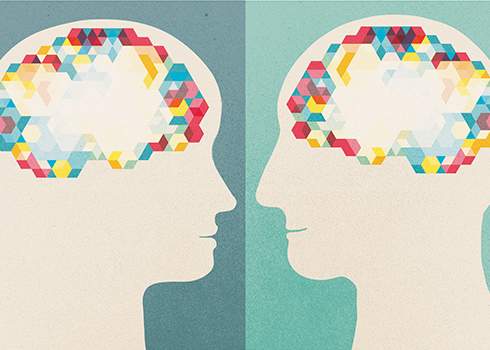In 1992, scientists at Italy’s University of Parma announced the genuinely exciting discovery that certain neurons in the premotor cortex of macaques fire under two quite different conditions: when the monkeys execute a specific action like reaching for food and when they merely observe an experimenter performing that action. Until then, the textbook wisdom in neuroscience had been that brain cells execute an action or observe one—not both. The Parma find seemed to show that “cells in the motor system fire when I see you make a movement, and they’re the same ones that fire when I make that movement,” according to neuroscientist Marco Iacoboni of the University of California, Los Angeles. “We didn’t think the brain was organized this way.” In 1996, these cells got their intriguing moniker, reflecting that the neurons “mirrored” observed behavior by firing as if the observer were not just seeing the action but also executing it.
It was like a starter’s pistol had gone off in the neuroscience lounge.
The discovery of mirror neurons would launch a “revolution” in understanding empathy and cooperation, predicted one researcher. Mirror neurons were “the driving force” behind the “great leap forward” in brain evolution, claimed another. They “will provide a unifying framework and explain a host of mental abilities that hitherto remained mysterious,” asserted a third, calling these cells “the neurons that shaped civilization.” Other researchers asserted that mirror neurons spurred the development of language (the human analogue of the monkeys’ premotor region is Broca’s area, which is involved in producing spoken language) and of theory of mind, our ability to infer what someone thinks, believes, or feels. Broken mirror neurons were invoked to explain autism, which is characterized by an inability to intuit others’ feelings and state of mind. One scholar invoked mirror neurons to argue for the superiority of face-to-face diplomacy, which, he said, allows negotiators “to transmit information and empathize with each other.”
The media piled on. Popular stories have invoked mirror neurons to explain everything from crying at movies to selfless acts of heroism and why hospital patients feel better when they have visitors.
To some neuroscientists, it was all a bit much. After giving a speech at the University of California, Davis, in 2010, I had dinner with members of the psychology department, and innocently asked about mirror neurons. From the collective eye roll, you’d think I’d asked about creationism. And as the number of scientific papers on mirror neurons approached 800 in 2012, Christian Jarrett of the British Psychological Society called them “perhaps the most hyped topic in neuroscience.” Psychology professor Morton Ann Gernsbacher of the University of Wisconsin told me recently, “Mirror neuron theory is being used as an explanation for many phenomena in social cognition without the claims being supported with actual data.”
Let’s try to separate wheat from chaff.
Do humans have mirror neurons? Given the similarities between our brains and monkeys’, we should. But clear evidence has been hard to come by, mostly because the most direct test—using electrodes to detect the firing of individual neurons to be sure the same ones fire during observing an action and executing it—is too invasive to be ethically done on healthy volunteers. In 2010, however, Iacoboni and his colleagues piggy-backed on epilepsy surgery, in which such electrodes are temporarily implanted into patients’ brains. Result: certain neurons fired when the patients both observed (on a laptop) and performed grasping actions and facial gestures.
Unfortunately, the study used only 21 patients and has not been independently confirmed. Also, the purported mirror neurons were not where monkeys’ neurons are but, among other places, in regions involved in memory. That raised concerns that the neurons firing during both observation and execution were involved in remembering the action, and thus not true mirror neurons. As a 2013 review put it, research results “cannot yet furnish conclusive proof” that humans have them.
If we do, can mirror neurons cause us to feel other people’s emotions and therefore underlie empathy? Here’s the logic: the mirror circuitry that’s activated during both the performance and observation of an action is probably wired into the circuitry that “knows” the goal of that action, Iacoboni told me, since “actions come with intentions. Mirror neurons activate meaning or intention circuits from within. It’s deeper than cognitive understanding.” Similarly, the circuitry that produces smiles, frowns, or other expressions seems to be connected to circuits that encode the associated feeling (hence the common experience of feeling a little happier if you make yourself smile). Since mirror circuitry fires at the sight of someone else making a face, that would trigger the same “feeling” circuits as are tripped when we make the face. Presto: A mechanism for inferring what another person feels.
Skeptics point out, however, that we don’t need to perform an action in order to understand why someone is doing it or what it feels like. I understand my husband’s goal when he removes an outlet plate and starts pulling out wires even though my own motor neurons have never rewired a circuit. “We’re able to understand many actions— and the goals of those actions—which we’ve never executed ourselves,” Gernsbacher argued. “And there are people who can decipher the emotion in facial expression without being able to make the expressions themselves” due to brain damage or other disability. That suggests a mirror system, even if we have one, is not necessary for empathy or theory of mind.
Many scientific papers promise “evidence for mirror neuron dysfunction in autism,” but only some are confirmed by other labs. Even fewer use bulletproof methodology. Some of the autism/ mirror-neuron studies, for instance, used neuroimaging to measure brain activity when people with autism executed movements on their own or imitated gestures in a picture. The region suspected of harboring human mirror neurons showed less activity, compared to normally developing participants, during the imitation task.
But it’s not clear that imitating has much to do with autism, Gernsbacher and other critics point out. “Many studies have found that neither autistic children nor autistic adults have any difficulty understanding the intention of other people’s actions,” as would be predicted by the mirror-neurons/ autism hypothesis, she said. “The bulk of brain imaging studies fail to support it.”
Mirror neurons were indeed a paradigm-changing discovery. From the observation that some premotor neurons fire when action is observed rather than performed, however, it is quite a leap to empathy, autism, and the rest. It’s natural to root for the human brain to have as many cool components as possible, and enticing to think that one of them offers a simple and elegant answer to the question of what make us human. But even if it turns out that we don’t have these nifty mirror neurons, it doesn’t make us any less empathetic. We just lack a simple neurological explanation for it.
Tomorrow’s sociologists will have a field day studying how claims about mirror neurons became part of the popular culture even as neuroscientists became skeptical of the unbridled exuberance. It’s a great case study of how once a scientific notion takes hold in the popular mind, it’s hard to jam it back into Pandora’s box.








